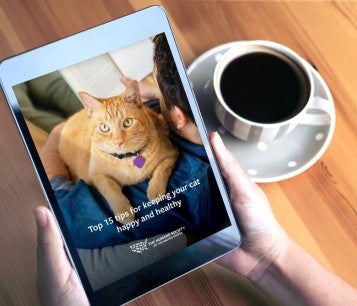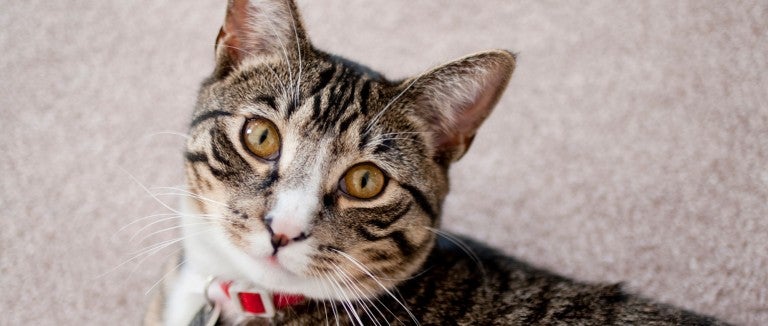It can happen in a flash—a door left ajar, a loose window screen, a carrier that didn’t latch properly—and suddenly your beloved cat has joined the lost pet postings that fill Facebook, Nextdoor and other social media sites.
An estimated 15% of cats will become lost at least once. If your cat is wearing a collar and ID tag, anyone who comes across your pet can easily read the tag, give you a call and get your kitty back to you—sparing your cat a trip to the shelter and a stressful stay while waiting for you to come claim them. You’ll also avoid the heartbreak of your cat being adopted by people who think they’re rescuing an “abandoned” pet.
Sign up to receive our exclusive e-book full of important information about keeping your cat healthy and happy.

Why your cat needs both a collar and a microchip
When it comes to microchips and ID tags, it’s not an either-or proposition. Cats with both microchips and ID tags are more likely to be reunited when lost than cats who have just one type of identification. Microchips are important because they’re permanent. Collars can be lost or removed; tags can fall off the collar. But the people most likely to come across your AWOL cat won’t have the equipment needed to detect and read a microchip.
Another benefit of collars and tags if that they allow you to communicate with strangers what to do if they encounter your pet. So, for example, if your cats are strictly indoors, you can include language on their collar or tag such as “I’m lost. Please call my owner.” If your cats are allowed outside, or you care for an extroverted community cat, a collar and ID can inform a Good Samaritan that the kitty isn’t homeless and doesn’t need rescuing.
Cats tolerate collars better than you might think
You may be afraid to put a collar on your cat because you’re worried they’ll be injured or think that they won’t tolerate a collar. However, the risk of an injury due to a collar is considerably less than the risks a cat encounters when lost outside. You can change your cat’s attitude–and yours–about collars. Focus on fit and safety when choosing a collar, and keep these tips in mind:
- “Breakaway” collars have plastic fasteners designed to open automatically when the collar is pulled; such collars may come off more easily but will help ensure a safe release if your cat’s collar is caught on something.
- Look for collars that adjust by sliding, which offer a better fit than those that use a traditional buckle-and-hole closure.
- When outfitting your cat, you should be able to comfortably slip two fingers (side by side, not one on top of the other) between the collar and your cat’s skin. A proper fit keeps the collar from sliding off at the mere swipe of a paw and also prevents it from snagging on something.
- When acclimating your cat to a collar, distract them with a tasty treat, a favorite game, a catnip toy or something else they like. Try rubbing the collar on your cat’s body, since cats feel more comfortable surrounded by their own scent.
- Be sure to check the collar frequently to ensure it still fits properly, particularly during the first couple of days. Continue to check the collar fit as your cat matures or gains or loses weight.
- It may help to get cats used to their new accoutrements gradually, at first keeping the collars on only while you’re home to supervise. If jingling tags drive you or your cat crazy, stick them together with Velcro or double-sided tape, purchase a tag silencer, or use engraved nameplates that slide onto or attach to the collar. For maximum kitty comfort, avoid large dog tags and opt for something cat-sized.
- Regularly check the collar and tag for wear and fading. Replace old or worn-out collars, and make sure the writing on the tag is still legible and the phone number is up to date.
- Keep an extra collar and tag handy. Collar loss is common, so it helps to have a spare.
- Flea collars shouldn’t be used to attach an ID tag.
- Don’t use a collar for walking your cat on a leash—use a properly fitted harness.
